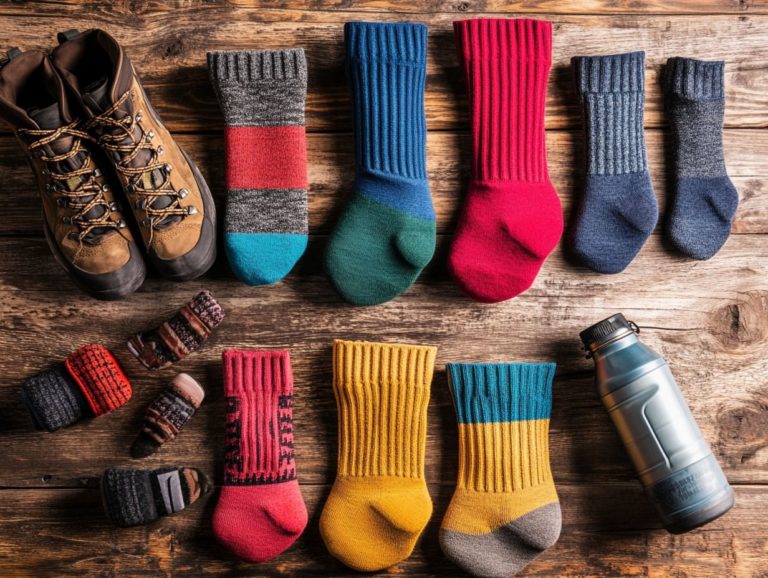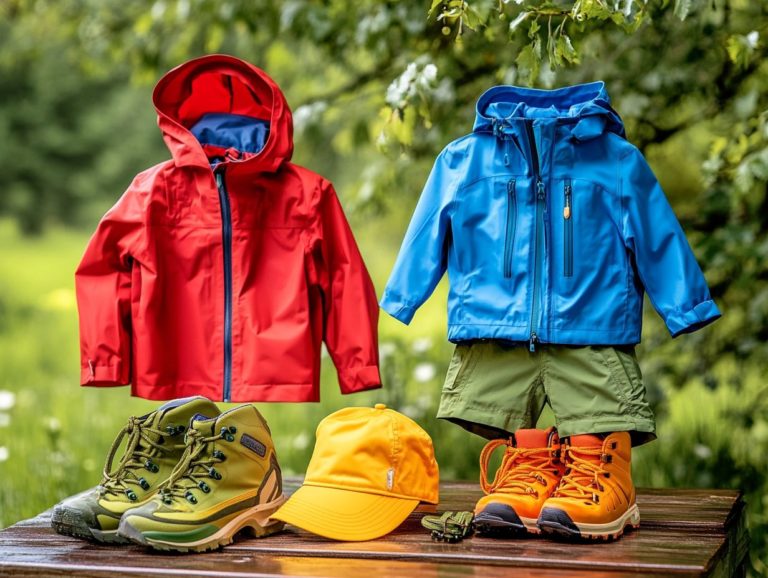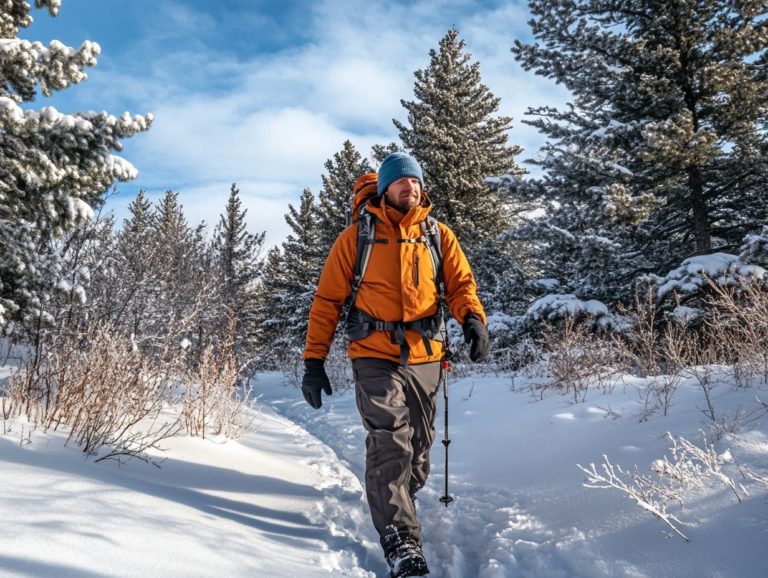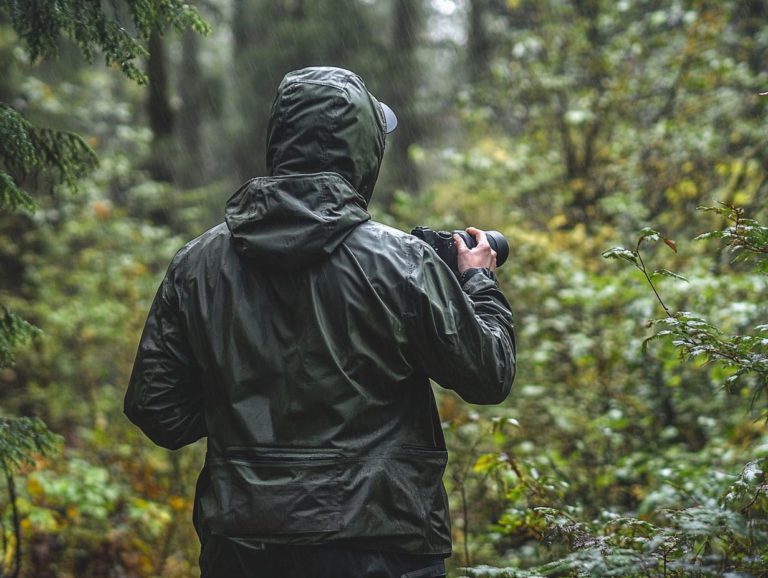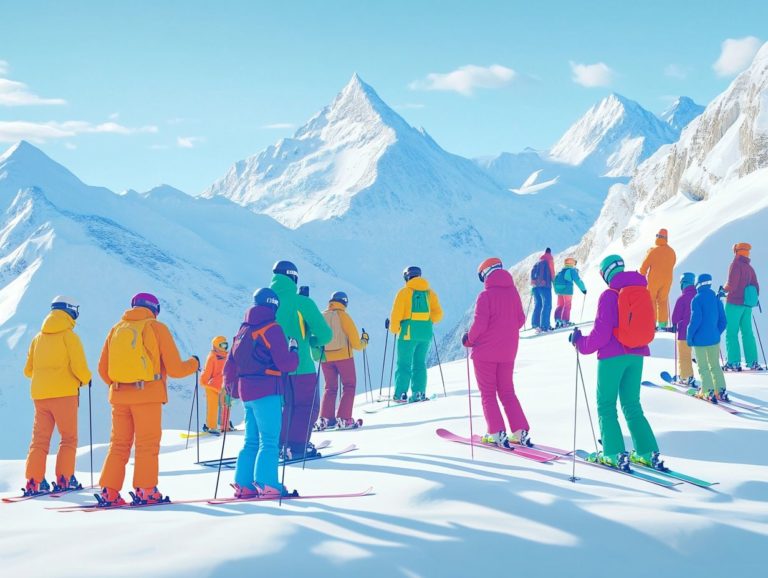The Best Clothing for Hiking in Different Climates
Choosing the right clothing for hiking is essential for both comfort and safety, particularly considering the diverse climates and terrains you may encounter.
From blistering deserts to frigid mountains, each environment necessitates specific gear to enhance your overall experience.
Get ready to explore the best clothing choices tailored for various conditions, layering techniques that maximize comfort, and the optimal materials to consider.
It will also pinpoint common missteps and offer valuable tips on effective packing.
Now, gear up and hit the trails!
Contents
- Key Takeaways:
- Why Your Clothing Choices Matter on the Trail!
- Hiking Clothing for Hot and Dry Climates
- Hiking Clothing for Cold and Wet Climates
- 4. Hiking Clothing for High Altitude and Mountainous Terrain
- 5. Layering Techniques for Hiking in Changing Climates
- 6. Essential Clothing Items for All Hiking Trips
- 7. How to Choose the Right Footwear for Different Hiking Conditions
- 8. Clothing Accessories That Can Make a Difference
- 9. What to Wear for Hiking in the Desert
- 10. What to Wear for Hiking in the Tropics
- 11. What to Wear for Hiking in the Mountains
- 12. What to Wear for Hiking in the Winter
- 13. What to Wear for Hiking in the Rain
- 14. What to Wear for Hiking in the Snow
- 15. How to Pack and Organize Your Hiking Clothing for Different Climates
- What Are the Most Common Clothing Mistakes Hikers Make?
- Frequently Asked Questions
- What are the best clothing options for hiking in hot climates?
- What should I wear when hiking in cold climates?
- What materials should I avoid when choosing clothing for hiking in humid climates?
- Is it important to consider the terrain when choosing clothing for hiking?
- What are some key features to look for when choosing hiking clothing for all climates?
- Do I need to wear different clothing for day hiking versus overnight hiking?
Key Takeaways:
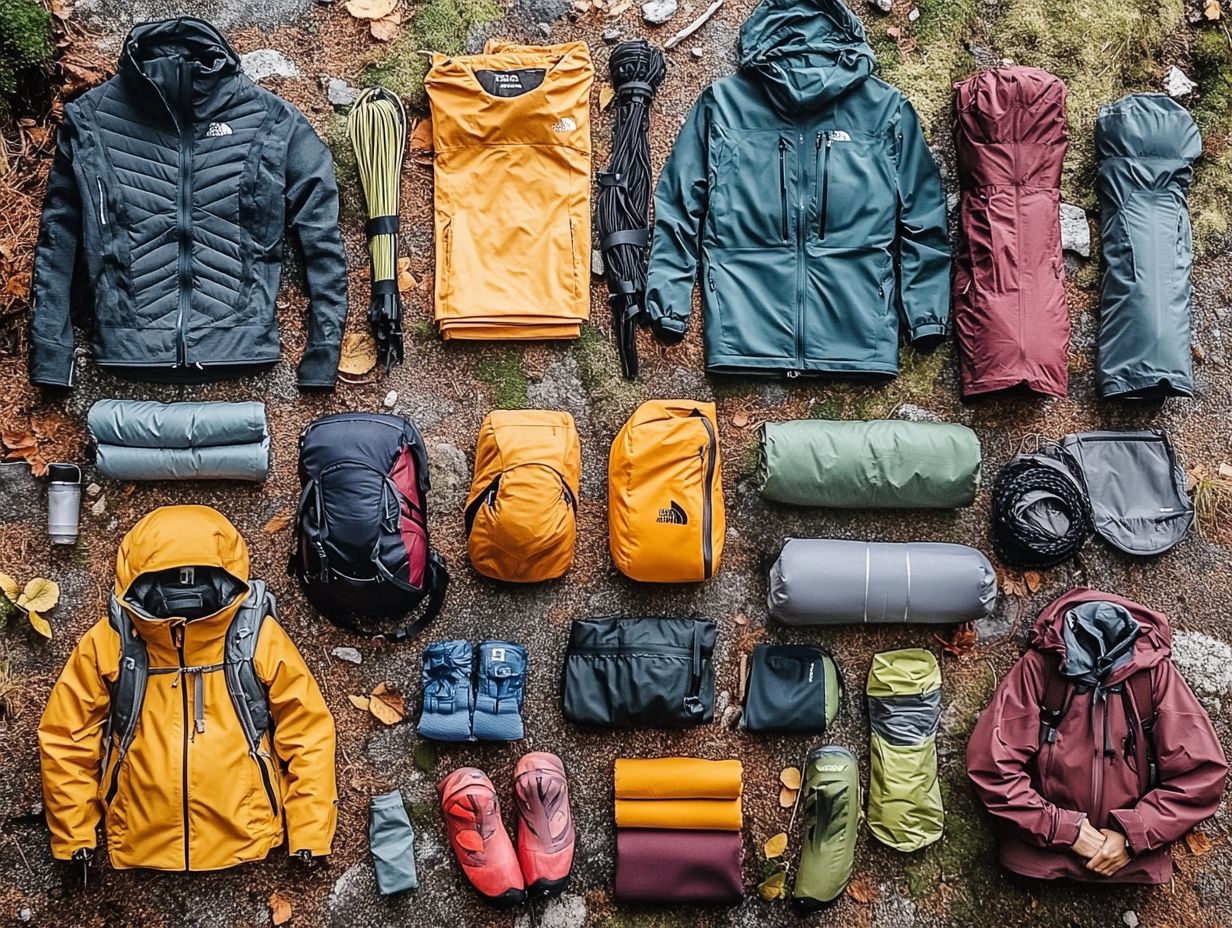
- Select the right clothing for hiking to improve performance and stay comfortable in changing climates.
- Consider the climate and terrain when selecting hiking clothing. Lightweight and breathable fabrics are ideal for hot and dry climates, while waterproof and insulated options are necessary for cold and wet conditions.
- Proper layering and footwear are essential for hiking in different climates and terrains. Accessories like hats, sunglasses, and gloves can enhance comfort and safety.
Why Your Clothing Choices Matter on the Trail!
Choosing the right clothing for hiking is essential for ensuring your comfort, performance, and safety during outdoor excursions. The specific materials and layering techniques you select can significantly impact your experience in varying weather conditions whether you’re navigating through chilly temperatures, sweltering heat, or high altitudes. Making informed choices is vital for your success and enjoyment as a hiker.
Understanding the various types of hiking clothing is crucial. Base layers are designed to pull sweat away from your skin, mid layers provide insulation, and top layers offer weather protection. Base layers are usually crafted from merino wool or synthetic materials, both excelling in breathability. Mid layers, like fleece or insulated jackets, help retain body heat in cooler temperatures, while top layers, such as waterproof jackets, shield you from rain and wind.
Selecting the right combination not only enhances your comfort but also boosts your overall hiking performance. This way, you can stay dry, warm, and fully focused on the adventure that lies ahead.
Hiking Clothing for Hot and Dry Climates
When you re hiking in hot and dry climates, choosing the right clothing is essential for sun protection and comfort. Opt for breathable materials that keep you cool while minimizing the risk of overheating.
Lightweight shirts made from synthetic fabrics are a smart choice; they promote ventilation and provide a barrier against harmful UV rays. Breathable pants are equally important, allowing air to circulate and safeguarding your skin from direct sunlight. Don t forget a broad-brimmed hat; it s vital for providing shade to your face and neck, adding an extra layer of defense against the sun s relentless rays.
Choosing light colors can help reflect sunlight, while moisture-wicking fabrics whisk away perspiration, boosting your comfort during challenging hikes. Steer clear of cotton clothing; it retains moisture and can lead to chafing. Instead, prioritize quick-drying materials for a more enjoyable hiking experience.
Hiking Clothing for Cold and Wet Climates
In cold and wet climates, selecting the right hiking clothing is crucial for keeping warm and dry. It s essential to invest in a waterproof layer, effective insulating materials, and a well-thought-out layering system to ensure your comfort and protection against the elements.
Start with a moisture-wicking base layer, which helps manage sweat while keeping you warm by moving moisture away from your skin. On top of that, a fleece jacket serves as an excellent insulating layer, trapping heat without adding unnecessary bulk. Top off your outfit with a down jacket for superior warmth in chilly conditions, especially when paired with a reliable waterproof shell that shields you from rain and wind.
Mastering layering techniques is key, allowing you to make quick adjustments based on temperature fluctuations during your hikes. Brands like Patagonia and Arcteryx provide a variety of high-performance clothing items, ensuring you re well-equipped to tackle even the most challenging weather conditions.
4. Hiking Clothing for High Altitude and Mountainous Terrain
When you re hiking in high altitudes and mountainous terrain, choosing the right clothing is crucial for managing temperature. You need a layered approach for ever-changing conditions, featuring breathable materials and durable designs that can handle environmental challenges.
To maximize your comfort, invest in a reliable base layer made from fabrics that draw sweat away from your skin. This helps you avoid chilling moments. A solid mid-layer provides necessary insulation; materials like fleece trap heat while allowing breathability.
Don t underestimate the importance of an outer layer, essential for protecting against wind and rain. Don t miss out on options from trusted brands like Columbia and Gore-Tex, which deliver exceptional waterproofing without compromising breathability. Combine these layers to create a powerful defense against the elements!
5. Layering Techniques for Hiking in Changing Climates
Mastering layering techniques is essential for hikers navigating changing climates. Adapting your clothing system with base layers, mid layers, and top layers significantly elevates your comfort and performance, especially in unpredictable weather.
Understanding the distinct roles of each layer transforms your experience. Base layers wick away moisture, keeping your skin dry and comfortable, which is vital during intense activity. Opt for materials like polyester or merino wool for optimal moisture management. The mid-layer adds insulation, trapping warmth; fleece and lightweight down are excellent choices.
Your top layers shield you against wind, rain, and cold, utilizing breathable, waterproof materials like Gore-Tex. Ensure that each piece fits well without restricting movement, allowing for easy adjustments as conditions shift throughout your hike.
6. Essential Clothing Items for All Hiking Trips
When gearing up for your next hiking adventure, certain essential clothing items are crucial for ensuring your comfort, safety, and overall enjoyment. Quality hiking boots, warm socks, protective gloves, and hydration packs are all vital for a successful experience, no matter the climate.
Footwear
A sturdy pair of hiking boots is absolutely key; they provide the support and traction you need on uneven terrain and help keep injuries at bay. When you pair these boots with moisture-wicking socks designed to draw sweat away from your skin you can say goodbye to blisters and hello to dry feet, even on the most challenging treks.
Socks
Avoid blisters and maintain comfort with the right socks. Choose moisture-wicking styles that keep your feet dry.
Gloves
Warm gloves are another essential; they shield you from the cold and improve your grip and dexterity, making it easier to handle your gear.
Hydration
And let s not forget a hydration pack it s vital for maintaining hydration levels, allowing you to fully immerse yourself in and enjoy the natural beauty surrounding you. This attention to detail transforms your adventure into a more fulfilling experience.
7. How to Choose the Right Footwear for Different Hiking Conditions
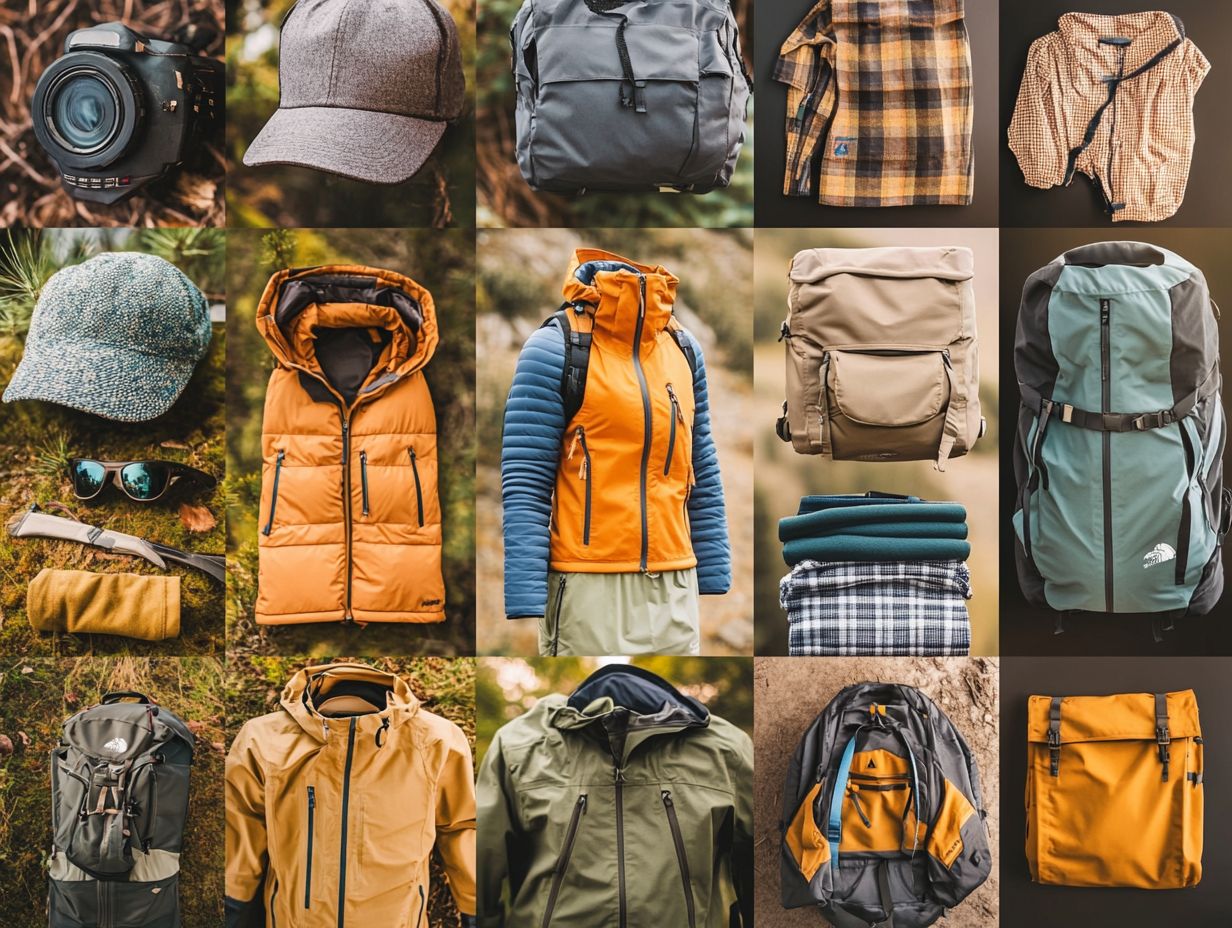
Selecting the right footwear for your hiking adventures is essential. The choice between hiking boots and shoes significantly impacts your comfort, support, and traction on various terrains, ensuring you have the right gear for your specific environment.
Hiking shoes are typically lighter and more flexible, making them perfect for well-maintained trails and warmer climates. In contrast, sturdy hiking boots offer superior ankle support and protection against rugged terrains, crucial for backcountry excursions.
As you evaluate your options, look for key features such as:
- Excellent traction to help you navigate slippery surfaces.
- Robust support that minimizes fatigue on challenging hikes.
- Waterproof capabilities to keep your feet dry during unexpected weather.
Brands like Columbia and REI Co-op truly shine in the realm of reliable hiking footwear, offering a range of styles that cater to your diverse hiking needs and preferences.
Gear up for your next hiking adventure with the right clothing!
8. Clothing Accessories That Can Make a Difference
Strategically selected clothing accessories can significantly elevate your hiking experience, providing essential benefits like sun protection, temperature regulation, and unparalleled comfort. Items such as a neck gaiter and a broad-brimmed hat are essential companions on your adventures.
When venturing into colder terrains, warm gloves become crucial. They help maintain your dexterity and warmth, allowing you to handle trekking poles or gear with ease. Hydration packs are your best friend for quick water access, ensuring that water is readily available while also distributing weight evenly to prevent unnecessary strain.
Each of these items plays a vital role in enhancing your safety and comfort on the trails. A well-fitted neck gaiter not only shields you from wind and dust but also adds an extra layer of insulation, making it a versatile addition for varying climates.
9. What to Wear for Hiking in the Desert
Hiking in the desert introduces unique challenges that demand careful clothing choices. Sun protection and breathability should be at the forefront of your mind. Opt for light colors and breathable materials to combat the intense heat and relentless UV rays. A broad-brimmed hat can provide additional sunburn protection.
Choosing garments made from moisture-wicking fabrics is key. These innovative materials draw sweat away from your skin, promoting quick evaporation and helping you maintain a comfortable body temperature.
Don t overlook the power of accessories like wide-brimmed hats and UV-blocking sunglasses they significantly boost your sun defense. Pairing smart clothing choices with hydration packs is vital. Stay hydrated dehydration can sneak up on you fast!
By prioritizing these elements, you ll ensure a safer and far more enjoyable desert hiking experience.
10. What to Wear for Hiking in the Tropics
When hiking in tropical climates, selecting the right clothing is essential for your comfort. The combination of high humidity and heat demands breathable materials and effective moisture management to keep you cool and prevent overheating. Fabrics that wick away sweat can enhance your experience significantly.
Opt for light colors to reflect sunlight, helping to maintain a comfortable body temperature. Clothing made from synthetic fabrics often boasts moisture-wicking properties that draw sweat away from your skin for a refreshing cooling effect.
Incorporating long sleeves and pants protects you from the sun s rays and shields you from pesky insect bites, all without sacrificing breathability. The right clothing choices will elevate your comfort and guard against potential heat-related illnesses, ensuring an enjoyable and safe hiking experience.
11. What to Wear for Hiking in the Mountains
Hiking in mountainous terrain demands your utmost attention to clothing choices. With temperatures that can fluctuate wildly and weather conditions that can change quickly, choosing the right insulation is key to staying warm and cozy on your hike. Invest in down jackets or fleece jackets for optimal insulation.
To navigate these challenges with ease, grasping the principles of layering techniques is essential. This method helps you adjust as conditions change.
- Begin with a moisture-wicking base layer that draws sweat away from your skin, ensuring you stay dry. Look for synthetic materials for optimal performance.
- Follow it up with insulating mid-layers; fleece or down are excellent choices for warmth. Choose materials that provide effective temperature control.
- Don’t overlook the importance of a versatile outer layer; it should be both waterproof and windproof to protect you from the elements. A good water-resistant jacket is essential.
When considering versatility, opt for hiking attire that’s easy to pack and quick-drying, ensuring you’re prepared for whatever conditions may arise. Understanding the evolution of hiking clothing can help you make informed choices. By thoughtfully adapting your clothing choices, you not only enhance your comfort but also significantly bolster your safety during outdoor adventures.
12. What to Wear for Hiking in the Winter
When venturing into winter excursions, selecting the right clothing is essential for ensuring your warmth and comfort. Focus on insulation materials and layering techniques that effectively combat the harshness of the cold. Invest in quality winter boots to maintain traction on icy surfaces.
A well-chosen down jacket is a prime example; it delivers excellent insulation while remaining lightweight, making it a must-have outer layer for any winter hike. Beneath that, fleece layers add versatility, trapping warmth and allowing you to easily regulate your temperature as your activity levels change.
Don t overlook the importance of thermal gloves they re essential. They provide insulation and moisture management, wicking away sweat to keep your hands warm and nimble.
Remember, making smart clothing choices keeps you warm while enhancing breathability and comfort during strenuous activities, allowing you to fully immerse yourself in the stunning winter landscapes.
13. What to Wear for Hiking in the Rain
Hiking in the rain requires careful clothing choices. Focus on waterproof layers and breathable materials to keep you dry.
Choose a windproof jacket for better protection against the elements. A well-planned rain hiking outfit is essential.
Include a high-quality waterproof jacket to repel water but let sweat escape. Underneath, wear moisture-wicking base layers to draw sweat away from your skin.
Don’t forget about breathable pants; they help with mobility and prevent overheating. Prioritizing these garments will ensure you enjoy the beauty of the great outdoors, rain or shine!
14. What to Wear for Hiking in the Snow
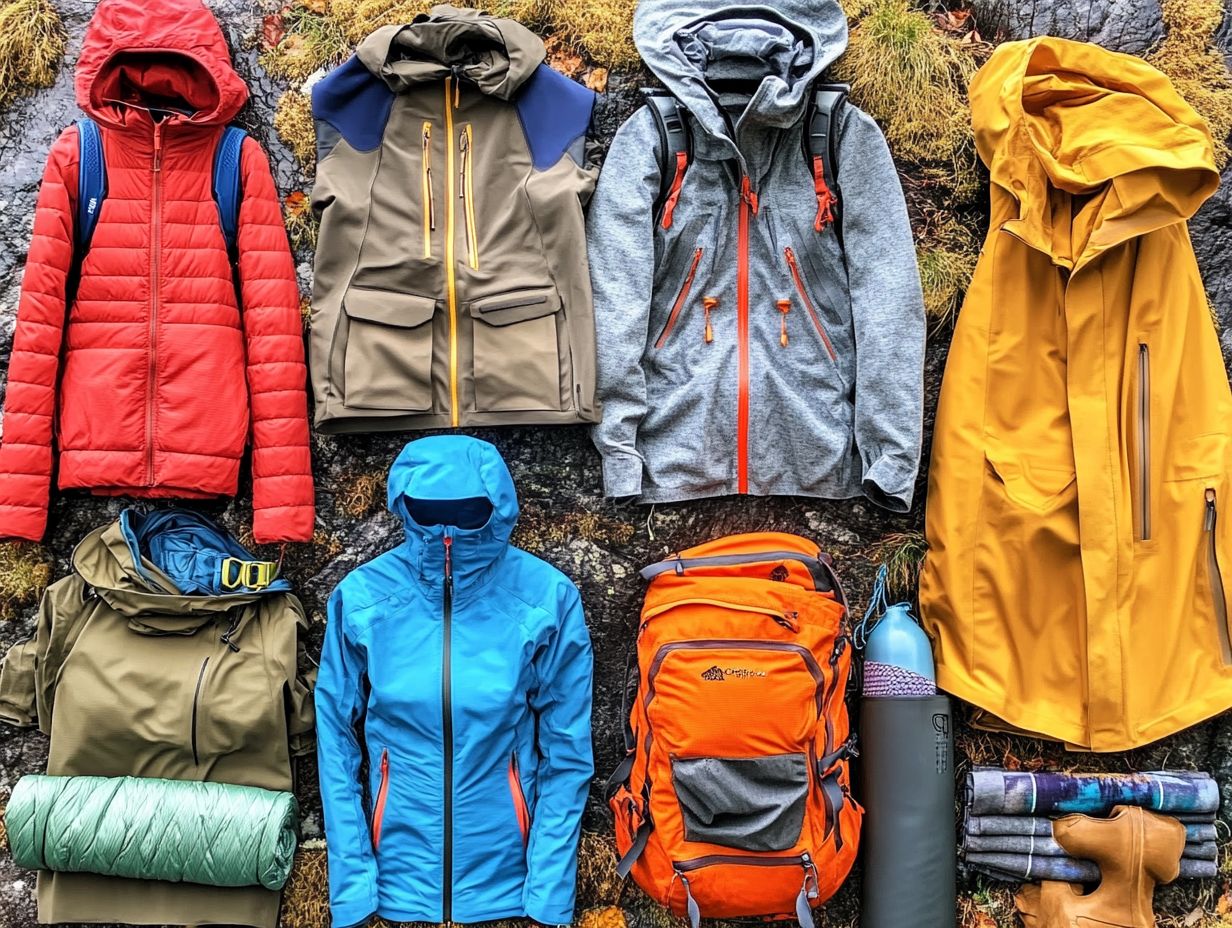
When hiking in the snow, choosing the right clothing is very important. Focus on waterproof layers and warm materials to stay dry and cozy.
High-quality warm socks are a must for cold weather. Ensure your gear is suited for snowy conditions.
An insulated jacket traps heat effectively. Good waterproof pants will keep snow and moisture away, ensuring comfort.
Layering is key. Start with moisture-wicking base layers, then add insulating mid-layers to retain warmth. Finish with a durable, weatherproof outer layer to protect against the elements.
Every layer plays a vital role in keeping your optimal body temperature. Make sure these are part of your winter hiking ensemble!
15. How to Pack and Organize Your Hiking Clothing for Different Climates
Packing and organizing your hiking clothing for different climates is essential for maximizing space and ensuring you have all the gear necessary to adapt to changing weather conditions. Layering techniques and strategic packing are vital components of your preparation. Consider investing in compression bags to save space.
Make a clear plan that organizes your clothing into functional layers that complement one another. Keep your base layers, insulating layers, and waterproof outer layers easily accessible, especially when the weather decides to surprise you.
Use compression bags for bulkier items; they save space and keep your gear neat. Stash small yet essential items like an extra pair of socks or a lightweight rain jacket in the top compartment of your pack.
This way, you can quickly grab what you need, ensuring you can enjoy your hike, no matter the weather.
What Are the Most Common Clothing Mistakes Hikers Make?
Many hikers make common clothing mistakes that can impact their outdoor experience. Choosing cotton clothing, for instance, can trap moisture against your skin, leading to discomfort and even hypothermia in chilly conditions. Avoiding cotton is crucial for your comfort, especially in wet environments.
Improper layering can also pose significant challenges during a hike. If you neglect to wear base layers that pull moisture away from your skin, you may find yourself accumulating sweat, which can chill you as your body cools down.
To address this, prioritize synthetic or merino wool fabrics that efficiently draw moisture away from your skin. It s crucial to balance insulation and ventilation; effective layering allows you to adjust according to terrain or changing weather.
Planning your outfit is key! It boosts your comfort and safety for an unforgettable adventure through the great outdoors.
How Can Proper Clothing Improve Hiking Performance?
Wearing the right clothing can dramatically elevate your hiking experience. It allows for effective moisture management and temperature control. This means you can concentrate on the beauty of your journey instead of being distracted by discomfort from ill-suited attire. Investing in quality boots also enhances your performance on the trails.
Opting for materials like merino wool or high-quality synthetic fabrics significantly reduces sweat and helps regulate your body temperature. A moisture-wicking base layer keeps your skin dry, while a breathable mid-layer provides insulation without overheating.
Don’t overlook the importance of a waterproof outer layer; it keeps you dry in unpredictable weather and enhances your overall comfort. The right footwear is essential. Shoes specifically designed for hiking offer superior traction and support, giving you the agility needed on rugged terrain.
Get excited about layering techniques and selecting the right materials to enhance your performance and fully immerse yourself in the adventure that lies ahead.
What Are the Best Materials for Hiking Clothing?
The best materials for your hiking clothing think merino wool and synthetic fabrics are essential for elevating comfort, moisture-wicking capabilities, and breathability. They are vital for a successful outdoor adventure.
When you embark on long treks through ever-changing weather, the benefits of these materials become apparent. Merino wool regulates body temperature and resists odors. It keeps you feeling fresh and comfortable, even after hours on the trail.
Meanwhile, nylon and polyester shine with remarkable durability and quick-drying properties. They are perfect for those unexpected rain showers or spills. These synthetic fabrics pull sweat away from your skin, keeping you dry and chafing-free.
By selecting the right combination of materials, you not only enhance your performance but also ensure a truly enjoyable hiking experience.
How Can Hikers Stay Comfortable in Changing Climates?
Staying comfortable in changing climates requires adaptability. Utilize the right gear and layering techniques to respond effectively to fluctuating temperatures and weather conditions.
Carefully select materials that wick moisture away from your body while providing insulation. Implement moisture management strategies by packing lightweight, breathable fabrics that dry quickly.
Don t underestimate the impact of accessories. A well-fitted hydration pack keeps you hydrated without the bulk of a traditional water bottle. A neck gaiter serves multiple purposes protecting against wind and cold while easily converting into a headband or face mask as needed.
Incorporating these elements into your hiking experience enhances overall comfort and promotes safety in unpredictable conditions. Choose the right materials today, including the best outdoor clothing choices for family hikes, and enjoy your hike to the fullest!
What Are the Essential Factors to Consider When Choosing Hiking Clothing?
When selecting your hiking clothing, there are several essential factors to consider. First, think about the expected weather conditions, the importance of moisture management, and insulation to keep you comfortable and performing well throughout your hike.
Fit is paramount. Clothing that s too loose can snag on branches, while gear that s too tight may restrict your movement.
The choice of materials matters just as much. Breathable fabrics help you stay cool on warmer days, whereas thermal materials are vital for keeping you warm when temperatures drop. Moisture-wicking fabrics pull sweat away from your skin, enhancing comfort.
Don’t overlook layering options, either. Being able to adjust your clothing in response to temperature shifts throughout the day is crucial, so selecting compatible pieces is a must. Ultimately, by understanding your personal preferences alongside the specific hiking environments you’ll encounter, you’ll be able to make informed clothing choices that significantly enhance your overall experience.
Frequently Asked Questions
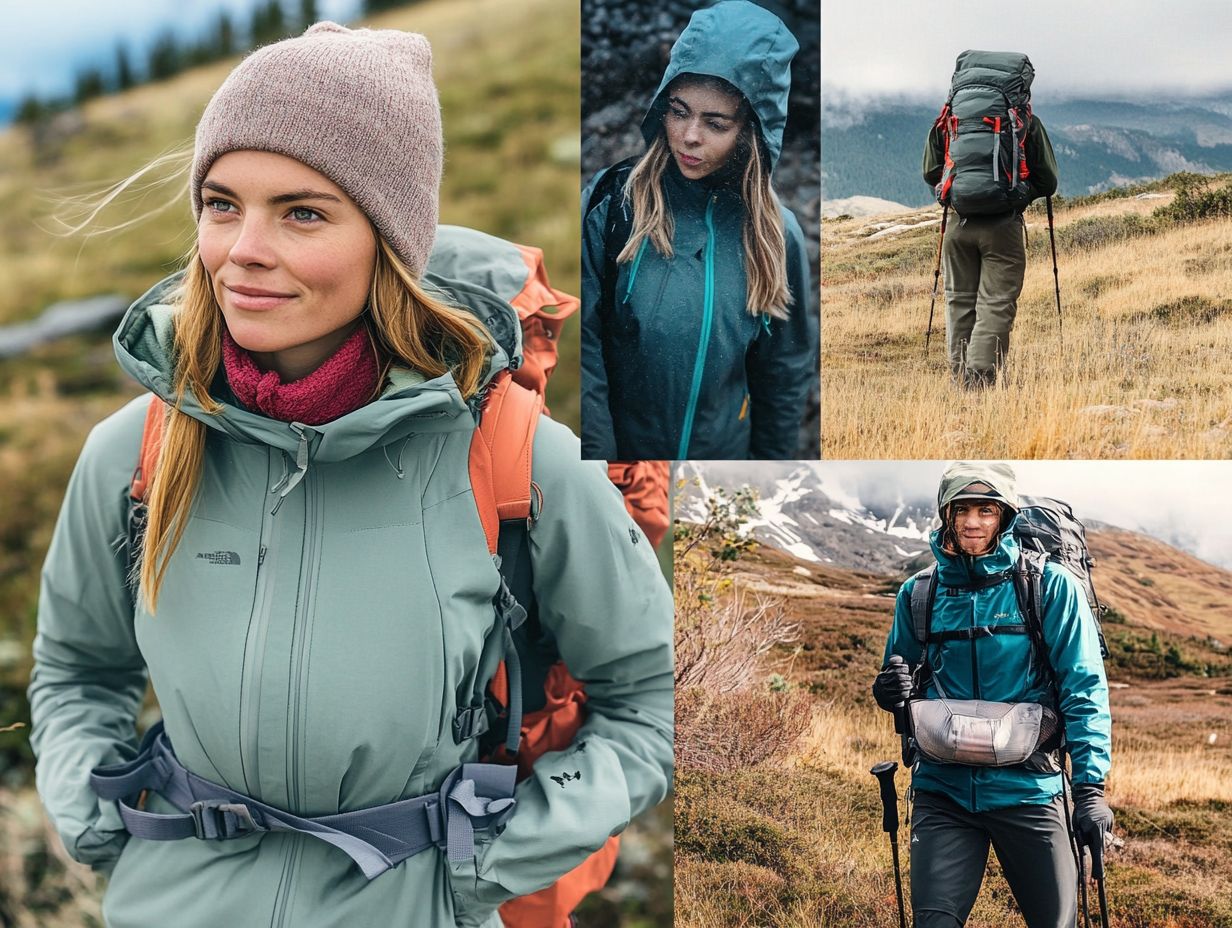
What are the best clothing options for hiking in hot climates?
When hiking in hot climates, choose lightweight and breathable clothing. Look for materials such as nylon or polyester that wick away sweat and keep you cool. Clothing with SPF protection or sun-blocking technology is also recommended to protect you from the sun’s harsh rays.
What should I wear when hiking in cold climates?
Dress in layers to stay warm and dry it’s essential for your comfort! Start with a base layer made of moisture-wicking material, followed by a mid-layer for insulation, and a waterproof outer layer to protect you from wind and snow. Don’t forget to also wear warm socks, gloves, and a hat to keep your extremities warm.
What materials should I avoid when choosing clothing for hiking in humid climates?
In humid climates, avoid cotton as it tends to retain moisture, making you feel uncomfortable and chafed. Instead, opt for synthetic materials such as nylon or polyester, which are quick-drying and will keep you cool and dry.
Is it important to consider the terrain when choosing clothing for hiking?
Yes! Consider the terrain when choosing clothing for hiking. For example, if hiking in rocky terrain, wear durable pants to prevent scrapes and scratches. For steep or slippery terrain, wear sturdy hiking boots with good traction.
What are some key features to look for when choosing hiking clothing for all climates?
When choosing clothing for hiking in all climates, look for features such as moisture-wicking material, ventilation options, and UPF protection for sun exposure. It s also important to choose clothing that fits comfortably and allows for a full range of motion.
Do I need to wear different clothing for day hiking versus overnight hiking?
Wear similar clothing for both day hiking and overnight hiking. However, if camping overnight, have an extra set of clothing for sleeping to stay warm and dry. Pack an extra layer or rain gear in case of unexpected weather changes.
Ready for your next hiking adventure? Choose your gear wisely for an unforgettable experience!

